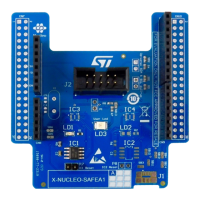6.7.1 LSE clock reference
There are three ways to configure the pins corresponding to the low-speed clock (LSE):
1. LSE on-board X2 crystal (Default configuration). Refer to the application note Oscillator design guide for
STM8AF/AL/S, STM32 MCUs and MPUs (AN2867) for crystal design guide for STM32 microcontrollers.
2. Oscillator from external to PC14 input, from external oscillator through pin 25 of the CN7 connector. The
following configuration is needed:
– SB3 ON
– R31 and R32 OFF
3. LSE not used. PC14 and PC15 are used as GPIOs instead of low‑speed clocks. The following configuration
is needed:
– SB3 and SB4 ON
– R31 and R32 OFF
6.7.2 HSE clock reference
There are four ways to configure the pins corresponding to the external high‑speed clock (HSE):
1. HSE not used: PF0 and PF1 are used as GPIOs instead of clocks. The configuration must be:
– SB5 and SB6 ON
– SB29 (MCO) OFF
– R33 and R34 OFF
2. MCO from ST-LINK: MCO output of ST-LINK is used as an input clock. This frequency cannot be changed,
it is fixed at 8 MHz and connected to the PF0-OSC_IN of the STM32 microcontroller. The configuration must
be:
– SB29 ON
– SB5 and SB6 OFF
– R33 and R34 OFF
3. HSE on-board oscillator from X3 crystal (default). For typical frequencies, capacitors, and resistors, refer to
the STM32 microcontroller datasheet and the application note Oscillator design guide for STM8AF/AL/S,
STM32 MCUs and MPUs (AN2867) for the oscillator design guide. The X3 crystal has the following
characteristics: 48 MHz, 7 pF, and 20 ppm. The configuration must be:
– SB5 and SB6 OFF
– R33 and R34 ON
– C25 and C26 ON with 4.3 pF capacitors
– SB29 OFF
4. Oscillator from external PF0, from an external oscillator through pin 29 of the CN7 connector. The
configuration must be:
– SB5 ON
– SB29 OFF
– R33 and R34 OFF
6.8
Reset sources
The STM32 Nucleo-64 reset signal is active LOW and the reset sources include:
• B2 reset push‑button
• Embedded ST-LINK/V2-1
• CN6 ARDUINO
®
connector pin 3
• CN7 ST morpho connector pin 14
UM2953
Reset sources
UM2953 - Rev 1
page 15/32

